4/28/2017
The Plant of the Hour
Kylee Baumle
Each year, the Perennial Plant Association names a Perennial Plant of the Year. Last August, when Asclepias tuberosa—butterfly weed—garnered the honors for 2017, you could hear Monarch butterfly fans screeching in delight across the country.
Milkweed is the only plant that the Monarch butterfly utilizes in its larval stage. It must have it or it can’t survive. The call to plant more milkweed has been sounding for some time now, as the Monarch numbers ha
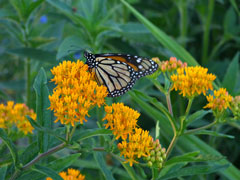
ve dwindled drastically since the mid-1990s and the advent of Roundup-ready crops.
Retailers have no doubt noticed an uptick in queries about plants in this genus and with the new designation, they’re sure to take a noticeable jump again. As one who is passionate about Monarch butterflies in particular and pollinators in general, and knowing how many others out there are like me, this is a real marketing opportunity.
How can we use what we know about both marketing and milkweed to make the most of this opportunity we’ve had handed to us?
Pictured: Monarch butterflies require milkweed in the larval (caterpillar) stage, but they and other pollinators will use it as a nectar source as well.
A Change in Attitude
First of all, milkweed has historically been up against some tough odds. Just having the word “weed” in its name doesn’t help its cause or yours. Farmers have been trying to get rid of it for decades. So let’s put some positive spin on it because there’s an awful lot to love about this family of plants. I prefer to call milkweed a wildflower because that’s just what it is. And once you start referring to it as that, your customers will see it in a new light. Who doesn’t love wildflowers?
While most gardeners think of common milkweed (Asclepias syriaca) when you talk about milkweed, show them there’s so much more! The U.S. has more than 70 species of native milkweeds and if you’re committed to helping Monarchs and other pollinators, as many of your customers are, you need to stock more than just a couple of varieties.
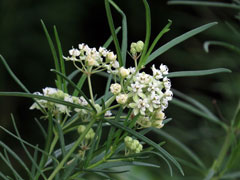 Pictured: If you can get hold of some whorled milkweed plants (Asclepias verticillata), be prepared for shocked looks when you tell your customers that this beautiful, airy, delicate-looking (yet tough), white-flowering perennial is a milkweed. It’s native to 40 out of 50 states and three provinces of Canada and you should be selling it.
Pictured: If you can get hold of some whorled milkweed plants (Asclepias verticillata), be prepared for shocked looks when you tell your customers that this beautiful, airy, delicate-looking (yet tough), white-flowering perennial is a milkweed. It’s native to 40 out of 50 states and three provinces of Canada and you should be selling it.
Front and Center
Secondly, don’t just stock milkweed plants without showcasing them. You’ll have some savvy gardeners who’ll come in and ask for them, but because the milkweeds have been so maligned over the years, many people will walk right by them without even knowing what they just passed up.
Signage is going to be paramount when selling milkweed, as it’s not likely that they’ll always be in bloom when you’re trying to sell them. Have images of what the blooms look like and provide helpful information about the plants, as customers may not be familiar with growing them. Let them know that because they’re native, they may be easier to grow than they think. Note also that most milkweeds can be grown as container plants, so be sure to pot some up in interesting containers for your customers who are restricted to growing on balconies or patios.
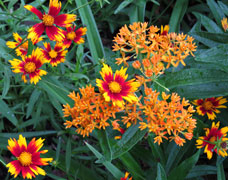 Pictured: Color sells, so take advantage of the brilliant orange color that butterfly weed wears so well. Pair it up in displays with other orange-flowering plants that butterflies love, such as Mexican sunflower (tithonia), blanket flower (gaillardia) and tickseed (coreopsis).
Pictured: Color sells, so take advantage of the brilliant orange color that butterfly weed wears so well. Pair it up in displays with other orange-flowering plants that butterflies love, such as Mexican sunflower (tithonia), blanket flower (gaillardia) and tickseed (coreopsis).
The Bigger Picture
People love a cause. They enjoy getting behind something that they think is worthwhile and for which they feel they’ll see tangible results from their efforts. Helping the Monarch butterfly is one of those causes and it comes with an added benefit. If you increase habitat to improve life for the Monarch, there are collateral benefits for other pollinators as well. Remind customers that every third bite of food we take depends on pollinators!
Customers will likely be requesting milkweed plants at the start of the season, when they’re planning and planting their gardens, but don’t be surprised if you see another surge of requests later in the summer. Interest is piqued in mid-August, as talk of the annual Monarch migration ramps up.
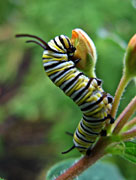
There are thousands of Monarch enthusiasts who raise Monarchs in captivity in order to increase the survival rate of the late-season generation (beginning about mid-August through fall) that will be making the trip to Mexico. In butterfly groups, it’s common to hear pleas for milkweed to feed Monarch caterpillars and just as common to hear despair when it’s reported that local garden centers don’t have any more milkweed available.
Pictured: Monarch caterpillars will dine on all parts of the milkweed plant—leaves, stems and flowers.
Just One More Thing . . .
Please remember that it’s crucial that the milkweed you sell not be treated with any chemicals, either after you receive your plants from a grower or before. Most often, those who are buying milkweed are doing so with the purpose of feeding Monarch caterpillars and many a sad tale has been told of caterpillar deaths due to growers’ or retailers’ chemical use. Make sure you can allay your customers’ fears about this by knowing for certain that the milkweed plants you sell haven’t been treated in any way.
Whether or not the collective individual efforts in an attempt to reverse the decline in the North American Monarch population by growing more milkweed will be effective is yet to be seen. But by growers, retailers and customers working together for a worthy cause, we all benefit from the attempt.
GP
Kylee Baumle is a freelance writer and photographer. She gardens on an acre in Northwest Ohio, where she also raises and tags migrating Monarch butterflies. She can be reached at ourlittleacre@gmail.com.
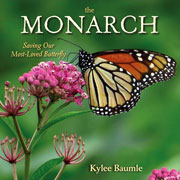
Kylee Baumle isn’t just the author of this article; she’s also the author of a new book released in April called “The Monarch: Saving Our Most-Lloved Butterfly.” Available now through St. Lynn’s Press, it tells the story of the Monarch’s steep decline in population, as well as its stunning migration to Central Mexico every fall. Kylee details the Monarch’s life cycle, action projects for all ages and how everyone can play a role in the butterfly’s restoration.